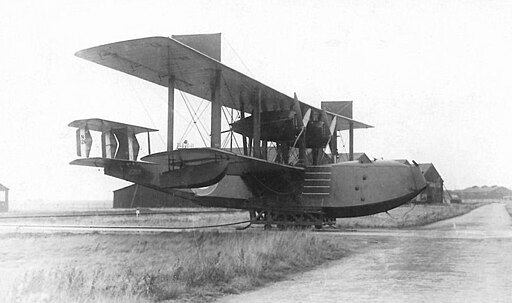
ASN Wikibase Occurrence # 233057
This information is added by users of ASN. Neither ASN nor the Flight Safety Foundation are responsible for the completeness or correctness of this information.
If you feel this information is incomplete or incorrect, you can submit corrected information.
| Date: | Wednesday 15 March 1922 |
| Time: | 12:30 LT |
| Type: | Vickers Valentia |
| Owner/operator: | Vickers Aircraft Ltd |
| Registration: | N125 |
| MSN: | |
| Fatalities: | Fatalities: 0 / Occupants: 3 |
| Aircraft damage: | Destroyed |
| Location: | English Channel, off St. Leonards-on-Sea, near Hastings, East Sussex -
 United Kingdom United Kingdom
|
| Phase: | En route |
| Nature: | Ferry/positioning |
| Departure airport: | Cowes, Isle of Wight |
| Isle of Grain, Kent | |
| Confidence Rating: |
Three Valentia prototypes were built by the Vickers Company at their Barrow works (Walney Island perhaps), having been ordered in May 1918 as a potential replacement for the Felixstowe F.5. The hull was built by S.E.Saunders works at Cowes. The first of the three (Serial Number N124) first flew on 5 March 1921, when Stanley Cockerell began test-flying it over the Solent. N124 was damaged on landing in June 1921 and was dismantled, the second N125 forced landed on its delivery flight on 15 March 1922. The third flying boat N126 was delivered in 1923 and used for trials until it was withdrawn from use in November 1924.
Vickers Valentia N125 was on its delivery flight from Cowes to the Isle of Grain when it made a forced landing off Hastings on 15 March 1922. It appears to have been damaged beyond repair after sinking at sea. According to a contemporary newspaper report ("Bexhill-on-Sea Observer" - Saturday 18 March 1922)
"FLYING BOAT WRECKED.
CREW BROUGHT ASHORE AT BEXHILL.
Although the Valentia, the giant flying boat, nose-dived into the sea off St. Leonards Pier just after noon on Wednesday, the crew were brought ashore at Bexhill in the Unity, a Hastings fishing vessel.
The machine, which had just completed her tests, was on her way from Cowes to the Isle Grain, where she was to have taken up duty on Wednesday. Flying low, she passed Bexhill about 12-30, and attracted considerable attention. Off West Marina, St. Leonards, she got into difficulties, and came down into the sea. She had on board Captain S. Cockerell and Captain B. C. Browne. D.F.C., the Vickers pilots who recently flew from England to Central Africa an attempt to reach Cape Town, and a mechanic named James Wyatt.
The machine struck the water with such force that she was thrown up again and broke her buck, leaving the tail and the wings, which were buckled, sticking out of the water. The three men who were clinging the wreckage were rescued, after they had been in the water about 25 minutes, by a Hastings rowing boat, which was launched by Alfred Bowra, aged 70, and another man, but were subsequently transferred to the Unity. The Hastings lifeboat also put out.
The engine of the Unity broke down, but the little vessel was also fitted with sails, and, running before the wind, she was able to make the shore just east of the Colonnade.
In the meantime the Bexhill Coastguard had telephoned for Dr. Murdoch. He saw the three men, who were brought ashore in an exhausted condition—one had severe cut on the forehead—and ordered their removal to the East Sussex Hospital, where they were taken a taxicab, which had also been summoned by the Coastguard. The wreckage meanwhile was drifting across the bay. Three Bexhill boatmen, named Brown, Buxton, and Moore, put out in their motor boats in an endeavour to salve her. Mr. Buxton was the first to make fast, and he was later joined by the other two, and further assistance came from Hastings. They towed the Valentia past Pevensey, where the Bexhill boatmen left her owing to the dangerous currents and off-shore wind, which were carrying them out to sea. Coming back two of the Bexhill boats developed engine trouble, and Mr. Buxton, after towing one back, returned for the other, which met at Veness Gap, and also helped it home.
The Valentia was recently completed by Messrs. Vickers for the Air Ministry, and is the second of that name to be wrecked."
Sources:
1. The Aeroplane of 22 March 1922
2. Bexhill-on-Sea Observer - Saturday 18 March 1922
3. http://sussexhistoryforum.co.uk/index.php?topic=14694.0
4. https://en.wikipedia.org/wiki/Vickers_Valentia#History
Media:
No photo found of Valentia N125. The photo below is of her sister ship Valentia N126:

Revision history:
| Date/time | Contributor | Updates |
|---|---|---|
| 18-Feb-2020 18:37 | Dr. John Smith | Added |
| 18-Feb-2020 18:37 | Dr. John Smith | Updated [Embed code] |
Corrections or additions? ... Edit this accident description
The Aviation Safety Network is an exclusive service provided by:


 ©2024 Flight Safety Foundation
©2024 Flight Safety Foundation